最新人教版七年级英语下册教案 unit11 第3课时 教案
- 格式:doc
- 大小:998.00 KB
- 文档页数:4
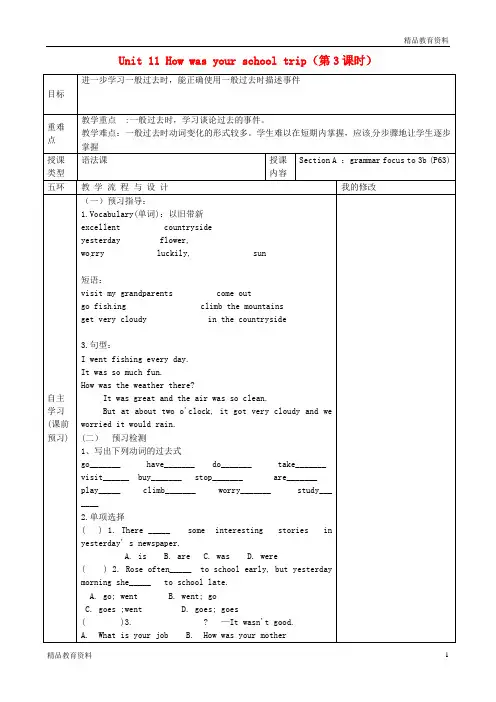
Unit 11 How was your school trip(第3课时)目标进一步学习一般过去时,能正确使用一般过去时描述事件重难点教学重点 :一般过去时,学习谈论过去的事件。
教学难点:一般过去时动词变化的形式较多。
学生难以在短期内掌握,应该分步骤地让学生逐步掌握授课类型语法课授课内容Section A :grammar focus to 3b (P63)五环教学流程与设计我的修改自主学习(课前预习) (一)预习指导:1.Vocabulary(单词):以旧带新excellent countrysideyesterday flower,wo rry luckily, sun短语:visit my grandparents come outgo fish ing climb the mountains get very cloudy in the countryside3.句型:I went fishing every day.It was so much fun.How was the weather there?It was great and the air was so clean.But at about two o'clock, it got very cloudy and we worried it would rain.(二)预习检测1、写出下列动词的过去式go_______ have_______ do_______ take_______visit______ buy_______ stop_______ are_______play_____ climb_______ worry_______ study_______2.单项选择( ) 1. There _____ some interesting stories in yesterday' s newspaper.A. isB. areC. wasD. were( ) 2. Rose often_____ to school early, but yesterday morning she_____ to school late.A. go; wentB. went; goC. goes ;wentD. goes; goes( )3. ? —It wasn't good.A. What is your jobB. How was your motherC. Are you OKD. How was your weekend ( )4. last summer vacation?—I went to the beach in Hainan.A. What did you doB. When did you go thereC. What do you doD. How did you go there ( )5. —How was your school trip last week?—Pretty good! We_____ the history museumA. visitB. VisitedC. are visitingD. will visit合作学习运用(课中释疑) 1.小组交流句型学习情况,交流预习检测情况。
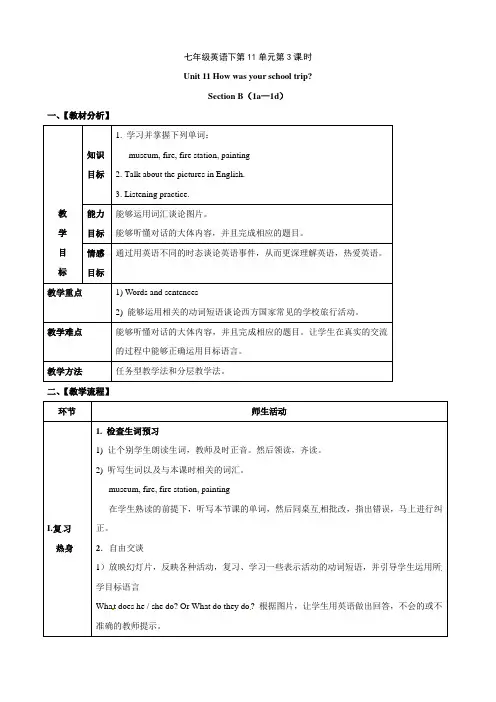
七年级英语下第11单元第3课时Unit 11 How was your school trip?Section B(1a—1d)一、【教材分析】教学目标知识目标1. 学习并掌握下列单词:museum, fire, fire station, painting2. Talk about the pictures in English.3. Listening practice.能力目标能够运用词汇谈论图片。
能够听懂对话的大体内容,并且完成相应的题目。
情感目标通过用英语不同的时态谈论英语事件,从而更深理解英语,热爱英语。
教学重点1) Words and sentences2) 能够运用相关的动词短语谈论西方国家常见的学校旅行活动。
教学难点能够听懂对话的大体内容,并且完成相应的题目。
让学生在真实的交流的过程中能够正确运用目标语言。
教学方法任务型教学法和分层教学法。
二、【教学流程】环节师生活动I.复习热身1. 检查生词预习1) 让个别学生朗读生词,教师及时正音。
然后领读,齐读。
2) 听写生词以及与本课时相关的词汇。
museum, fire, fire station, painting在学生熟读的前提下,听写本节课的单词,然后同桌互相批改,指出错误,马上进行纠正。
2.自由交谈1)放映幻灯片,反映各种活动,复习、学习一些表示活动的动词短语,并引导学生运用所学目标语言Wha t does he / she do? Or What do they do? 根据图片,让学生用英语做出回答,不会的或不准确的教师提示。
2) 教师提示,可以变换不同的时态,分组问答表演,教师要适时给予表扬。
II. 感知体验1、感知:运用所学的目标句型Wh at did she do?She went to the zoo. / She saw interesting animals. What did they do?They visited a museum.What did he do?He rode a horse.分组进行对话练习。
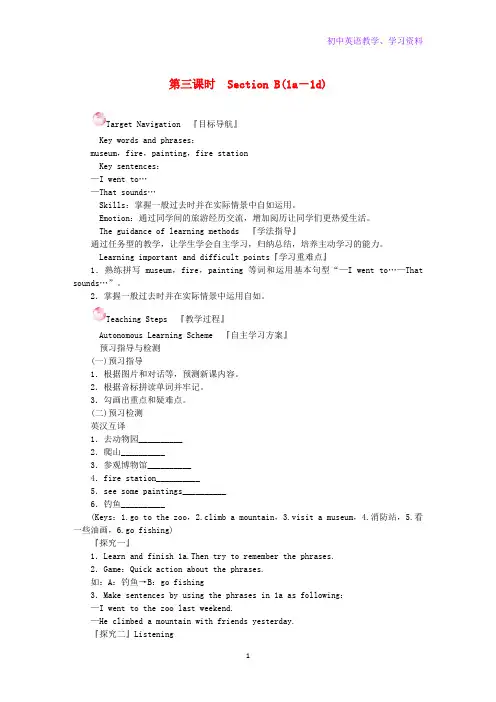
第三课时Section B(1a-1d)Target Navigation 『目标导航』Key words and phrases:museum,fire,painting,fire stationKey sentences:—I went to…—That sounds…Skills:掌握一般过去时并在实际情景中自如运用。
Emotion:通过同学间的旅游经历交流,增加阅历让同学们更热爱生活。
The guidance of learning methods 『学法指导』通过任务型的教学,让学生学会自主学习,归纳总结,培养主动学习的能力。
Learning important and difficult points『学习重难点』1.熟练拼写museum,fire,painting等词和运用基本句型“—I went to…—That sounds…”。
2.掌握一般过去时并在实际情景中运用自如。
Teaching Steps 『教学过程』Autonomous Learning Scheme 『自主学习方案』预习指导与检测(一)预习指导1.根据图片和对话等,预测新课内容。
2.根据音标拼读单词并牢记。
3.勾画出重点和疑难点。
(二)预习检测英汉互译1.去动物园__________2.爬山__________3.参观博物馆__________4.fire station__________5.see some paintings__________6.钓鱼__________(Keys:1.go to the zoo,2.climb a mountain,3.visit a museum,4.消防站,5.看一些油画,6.go fishing)『探究一』1.Learn and finish 1a.Then try to remember the phrases.2.Game:Quick action about the phrases.如:A:钓鱼→B:go fishing3.Make sentences by using the phrases in 1a as following:—I went to the zoo last weekend.—He climbed a mountain with friends yesterday.『探究二』Listening1.Go through the questions in 1b and the chart in 1c quickly.2.Listen and answer the questions in 1b.3.Listen again.What did Jane and Tony do on their last school trip?Complete the chart in 1c.Check Tony or Jane.Then check the answers.『探究三』Pair workDiscuss your last school trip with your partner.『探究四』Group work:总结归纳How…句型,如何回答?请举例说明。
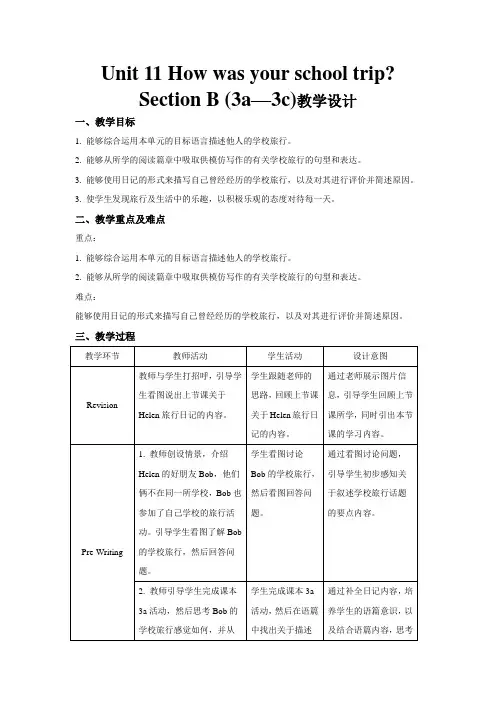
Unit 11 How was your school trip?
Section B (3a—3c)教学设计
一、教学目标
1. 能够综合运用本单元的目标语言描述他人的学校旅行。
2. 能够从所学的阅读篇章中吸取供模仿写作的有关学校旅行的句型和表达。
3. 能够使用日记的形式来描写自己曾经经历的学校旅行,以及对其进行评价并简述原因。
3. 使学生发现旅行及生活中的乐趣,以积极乐观的态度对待每一天。
二、教学重点及难点
重点:
1. 能够综合运用本单元的目标语言描述他人的学校旅行。
2. 能够从所学的阅读篇章中吸取供模仿写作的有关学校旅行的句型和表达。
难点:
能够使用日记的形式来描写自己曾经经历的学校旅行,以及对其进行评价并简述原因。
三、教学过程
四、板书设计
Unit 11 How was your school trip?
Section B (3a—3c) Describing a trip
➢Date: What was the date?
➢Place: Where did you go?
➢Transportation:How did you go there?
➢Activities:What did you see? / What did you do?
➢Feeling:How was the trip? / Did you like it?。

七年级英语下册Unit 11 第3时教案分析七年级英语下册Unit11第3时教案分析第三时SetinB【学习目标】通过听读、经历学生能正确读译和拼写单词useu。
2【学习重点】提高听说能力正确运用新单词及一样过去时。
【学习难点】用一样过去时描述自己及他人的旅行经历使学生体验到分享体会的欢乐。
【学习提示】Assequestinsbshingthephts1【学习提示】Revietherdseirhineseeaningsinthetext【学法指导】exited表示“兴奋的”指人、物对……感到兴奋;表示“令人兴奋的;令人兴奋的”指人、事、物本身让人兴奋、兴奋。
一样情形下人作主语用-ed;物作主语用-ing。
一样的道理其他类似的词surprising/surprised;interesting/interested等也是如此区分的。
2【学习提示】Finish1aingrups2.hetheansers3.Asstudentstlistent1b,1andfinishitThenlistenagainandrepeat【学法指导】beinterestedin【用法】对……感爱好【举例】IainterestedinEnglish我对英语感爱好。
情景导入生成问题.Questin:hat'sthisinthepiture?:_________________________________________________________ _______________2Questin:hat'shedinginthesiingpl?:________________________________________________________________________自学互研生成能力Tas1 Let'sreadnerdsIanread2.Ianrite参观消防站参观博物馆u去钓鱼登山去乡下画画去动物园看一些油画3.Iansuarize认真观看上面的动词短语写出他们的过去式并归类。
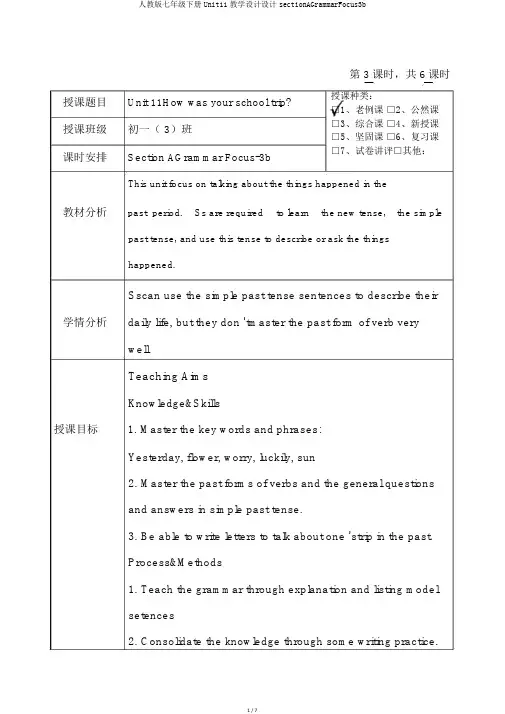
第 3课时,共 6课时授课题目Unit 11How was your school trip? 授课班级初一( 3)班课时安排Section AGrammar Focus-3b 授课种类:□1、老例课□2、公然课□3、综合课□4、新授课□5、坚固课□6、复习课□7、试卷讲评□其他:This unit focus on talking about the things happened in the教材分析past period. Ss are required to learn the new tense, the simple past tense, and use this tense to describe or ask the thingshappened.Sscan use the simple past tense sentences to describe their 学情分析daily life, but they don ’tmaster the past form of verb very well.Teaching AimsKnowledge&Skills授课目标 1. Master the key words and phrases:Yesterday, flower, worry, luckily, sun2. Master the past forms of verbs and the general questionsand answers in simple past tense.3. Be able to write letters to talk about one ’strip in the past.Process&Methods1. Teach the grammar through explanation and listing modelsetences2. Consolidate the knowledge through some writing practice.授课重点和难点Emotion, Attitudes&Values1.Lead Ss to share one ’s experiences and joy with each others.Important points1.Master the past forms of verbs and the general questions and answersin simple past tense.2.Be able to write letters to talk about one ’s trip in the past.Difficult points1.The past form of verbs and the general questions and answers insimple past tense.授课思路设计内容与方法选择:Situational Communicative授课工具的说明和使用:multi-media Approach, Task-based Approach, Multimedia Display tools, blackboard.Approach, Team Cooperation Approach授课步骤有关说明1. Grammar Focus总结语法规律,理解句子构造及用法。
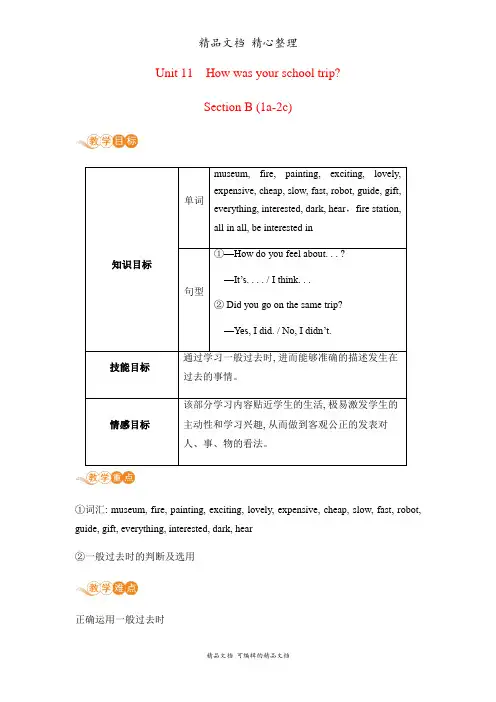
Unit 11 How was your school trip?
Section B (1a-2c)
①词汇: museum, fire, painting, exciting, lovely, expensive, cheap, slow, fast, robot, guide, gift, everything, interested, dark, hear ②一般过去时的判断及选用
正确运用一般过去时
2. Write a short passage about one of your trips.
长期以来受应试教育的影响, 学生的听力水平始终难以提高, 虽然听力测试
分数高, 但仍是“聋子”; 写作水平高, 却仍是“哑子”。
因此, 新课标要求教师在课堂上应努力做到让每个学生达到每堂课的听力目标、说的目标。
教师应充分做好课前准备, 熟悉每堂课的听力目标、说的目标; 充分估计学生在听的过程中可能遇到的障碍, 并考虑以何种方式解决; 充分考虑评价方式, 并做好评价记录(教师评价、学生自评)。
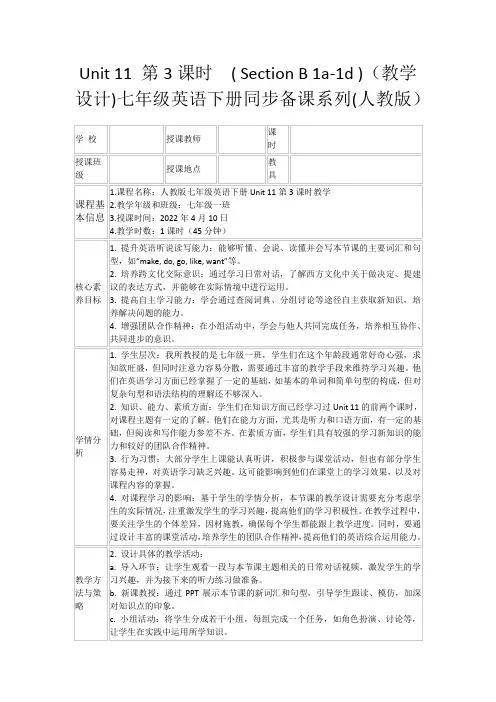
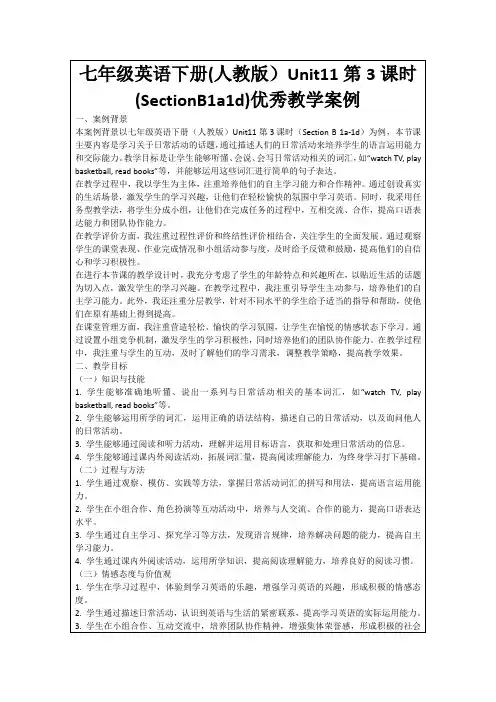
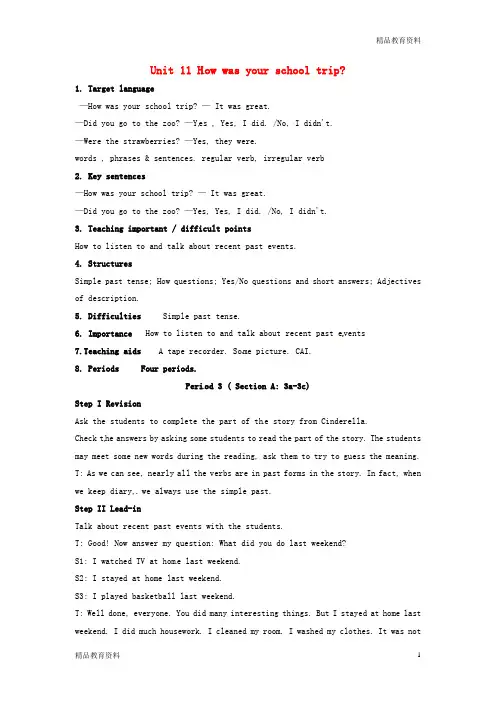
Unit 11 How was your school trip?1. Target language—How was your school trip? — It was great.—Did you go to the zoo? —Y es , Yes, I did. /No, I didn't.—Were the strawberries? —Yes, they were.words , phrases & sentences. regular verb, irregular verb2. Key sentences—How was your school trip? — It was great.—Did you go to the zoo? —Yes, Yes, I did. /No, I didn't.3. Teaching important / difficult pointsHow to listen to and talk about recent past events.4. StructuresSimple past tense; How questions; Yes/No questions and short answers; Adjectives of description.5. Difficulties Simple past tense.6. Importance How to listen to and talk about recent past e vents7.Teaching aids A tape recorder. So me picture. CAI.8. Periods Four periods.Peri od 3 ( Section A: 3a-3c)Step I RevisionAsk the students to complete the part of th e story from Cinderella.Check t he answers by asking some students to read the part of the story. The students may meet some new words during the reading, ask them to try to guess the meaning. T: As we can see, nearly all the verbs are in past forms in the story. In fact, when we keep diary, we always use the simple past.Step II Lead-inTalk about recent past events with the students.T: Good! Now answer my question: What did you do last weekend?S1: I watched TV at hom e last weekend.S2: I stayed at home last weekend.S3: I played basketball last weekend.T: Well done, everyone. You did many interesting things. But I stayed at home last weekend. I did much housework. I cleaned my room. I washed my clothes. It was notvery good, because I was very tired. Now answer: How was your weekend?He lp them answer.Ss: It was great / good / OK...Write down a nd get the students to read the dialogue:—How was your weekend? —It was grea t.Step III Reading and speaking (3a)1. Ask the students to describe what each person in each scene did.T: Look at the picture in 3a. Tell me what the person in each scene did.S1: In Picture 1: She went to the beach.S2: In Picture 2: He did his homework and watched TV.S3: In Picture 3: She cleaned her room and studied for the math test.2. Ask the students to read the e xpressions and the conversations.T: Now please read the expressions above the p icture and the conversations in the picture. The second part of each conversation is incomplete. They are listed above the picture. Read them and write the correct number on the blank lines in the speech bubbles to complete the conversations.Then check the answers by asking some students to read the completed conversations. Step IV Pairwork (3b)1. Ask the students to read the conversation in 3b first. And then ask them to make conversations.T: Now practice asking and answering questions about what the people in the pictures did last weekend. Practice in pairs. Use the dialogue as an example. Give the students two minutes to read and make the conversations.A: How was Sarah’s weekend?B: It wasn’t very good. She cleaned her room and studied for the math test. Sample conversations:1) S1: How was Tony’s weekend?S2: It was OK. He did his homework and watched TV.2) S3: How was Sarah’s weekend?S4: It wasn’t very good. She cleaned her room and studied for the math test. Step Ⅴ HomeworkAsk the students to finish the exercises.。
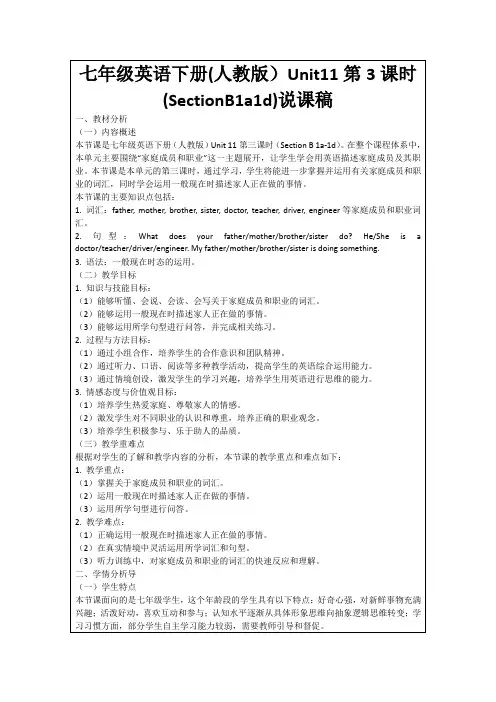
山东省郓城县随官屯镇七年级英语下册Unit 11 How was your school trip B(第3课时)1a-2a教案(新版)人教新目标版编辑整理:尊敬的读者朋友们:这里是精品文档编辑中心,本文档内容是由我和我的同事精心编辑整理后发布的,发布之前我们对文中内容进行仔细校对,但是难免会有疏漏的地方,但是任然希望(山东省郓城县随官屯镇七年级英语下册Unit 11 How was your school trip B(第3课时)1a-2a教案(新版)人教新目标版)的内容能够给您的工作和学习带来便利。
同时也真诚的希望收到您的建议和反馈,这将是我们进步的源泉,前进的动力。
本文可编辑可修改,如果觉得对您有帮助请收藏以便随时查阅,最后祝您生活愉快业绩进步,以下为山东省郓城县随官屯镇七年级英语下册Unit 11 How was your school trip B(第3课时)1a-2a教案(新版)人教新目标版的全部内容。
Unit 11 How was your school tripB第3课时 1a-2a 教学目标一、知识与技能1。
掌握有关活动的短语.2。
能熟练谈论过去发生的事情。
3. 能熟练掌握动词过去式的规则变化,以及学过的不规则变化的过去式。
4. 能够使用形容词对事件进行评价.5. 掌握重点词汇:museum, fire, fire station, painting.灵活运用句型:How was Jane’s trip?That sounds …What did you do …?Did you …?二、过程方法采用目标教学法,引导学生积极参与课堂,鼓励学生多读、善思。
三、情感态度与价值观培养合作意识并积极参与课堂。
教学重点1。
掌握有关活动的短语.2。
能熟练谈论过去发生的事情。
3。
能熟练掌握动词过去式的规则变化,以及学过的不规则变化的过去式。
4。
能够使用形容词对事件进行评价。
5. 掌握重点词汇:museum, fire, fire station, painting。
Unit 11 How was your school trip?Section B (1a-1d)一、教学目标1. 掌握以下词汇:museum, fire, fire station, painting2. 掌握以下词组:go to the zoo, visit a museum, climb a mountain, visit a fire station, go fishing, went to an art museum, saw some painting, drew pictures3.通过听关于谈论学校旅行经历的对话,使学生进一步感知一般过去时在口语交际中的语用功能。
4.通过听力活动掌握如何根据语调线索理解说话者的意图、观点或态度的听力技能。
5.通过谈论各自学校旅行经历,实现语言输出,让学生在与同学进行真实交流的过程中能够正确运用所学的目标语言。
6.了解国内外学校组织的各种浏览活动。
二、教学重点及难点重点:1. 能听懂接近自然语速、熟悉话题的简单语段,识别主题,获取主要信息。
2. 能听懂学习活动中连续的指令和问题,并做出适当的反应。
3. 能利用所给提示用一般过去时描述自己过去亲历的学校旅行。
难点:通过听力训练提高学生们获取信息的能力。
三、教学准备教师:教学课件;多媒体设备学生:课前预习四、教学过程Step 1. Warming-upAsk Ss to recall their trips and talk about them in groups using the words and expressions this unit. T: Hello, everyone! Did you have a trip? Now let’s talk about your trips with your partner using the words and expressions this unit.【设计意图】通过小组讨论各自的旅行,活跃课堂气氛,并顺利引入今天的学习。
人教版七年级英语下册说课稿:UNIT 11 Period 3 (Section B 1a-1d)一. 教材分析人教版七年级英语下册Unit 11 Period 3(Section B 1a-1d)主要讲述了在课堂上如何进行有效的提问和回答。
本节课的主要内容包括:一般疑问句的构成及其疑问词的运用,特殊疑问句的构成及其疑问词的运用,以及一般疑问句和特殊疑问句的回答方式。
通过本节课的学习,学生能够掌握一般疑问句和特殊疑问句的构成及用法,并能够运用所学知识进行有效的提问和回答。
二. 学情分析根据我对七年级学生的了解,他们在经过一段时间的英语学习后,已经掌握了一定的英语基础知识,能够进行简单的英语交流。
但是,他们在提问和回答问题时,往往缺乏准确性和完整性。
因此,在本节课的教学过程中,我需要帮助学生进一步巩固疑问句的构成及其用法,提高他们的提问和回答问题的能力。
三. 说教学目标1.知识目标:学生能够掌握一般疑问句和特殊疑问句的构成及其用法,理解疑问词的意义和用法。
2.能力目标:学生能够运用所学知识进行有效的提问和回答,提高课堂参与度。
3.情感目标:学生能够积极参与课堂活动,增强学习英语的兴趣和自信心。
四. 说教学重难点1.重点:一般疑问句和特殊疑问句的构成及其用法。
2.难点:疑问词的准确运用和一般疑问句及特殊疑问句的回答方式。
五. 说教学方法与手段在本节课的教学过程中,我将采用任务型教学法,通过提问、回答、讨论等方式,引导学生主动参与课堂活动。
同时,我会利用多媒体教学手段,如PPT、视频等,为学生提供丰富的教学资源,帮助他们更好地理解和掌握所学知识。
六. 说教学过程1.导入:通过复习上一节课的内容,引导学生进入本节课的学习主题。
2.课堂讲解:讲解一般疑问句和特殊疑问句的构成及其用法,疑问词的意义和用法。
3.课堂实践:学生分组进行角色扮演,模拟课堂提问和回答情景,教师给予指导和反馈。
4.巩固练习:学生完成课本上的练习题,教师及时批改和讲解。
Unit 11 Sad movies make me cry .
Section A Grammar focus-4b 一、【教材分析】
教学目标知识
目标
1. 会听说读写下列词汇:grey lemon cancel
2. 掌握并会运用下列重要句型:
(1)The loud music makes me nervous .
(2)Soft and quiet music makes people relaxed .
(3)Money and fame don’t alway s make people happy .
(4)She said that the sad movie made her feel like crying .
(5)Cloudy days make me sad .
(6)That made me very relaxed .
能力
目标
熟练运用语法要点中的句型和他人对话。
情感
目标养成积极良好的生活习惯,让学生关注自身健康。
教学重点熟练运用语法要点中的句型和他人对话。
教学难点make+宾语+形容词
教学方法情境教学法;任务型教学法
二、【教学流程】
环节师生活动
I. 复习热身1、检查生词预习。
(1)先通过PPT呈现本课的单词,教师领读,学生跟读,并帮助学生正音。
(2)做题巩固。
用所给单词的适当形式填空。
①Pop music makes people ______(feel)easy .
②The ______(hard)you work , the ______(great)progress you will make .
③Sad movies made me______(cry)
④Cloudy days make me______(sad).
⑤I found out that I ______(do)do too badly .
答案:①feel ②harder ③cry ④sadly ⑤did
2、自由交谈
学生观看图片,进行对话。
How do you feel about these following pictures?
It makes me comfortable.
It makes me relaxed.
Ⅱ.感知
体验
感知1. PPT展示图片,提出问题How does this picture make you feel?
体验1.学生根据问题展开讨论。
It makes me comfortable.
It makes me angry.
It makes me scared
感知2:PPT展示语法重点。
The loud music makes me nervous.
Soft and quiet music makes me relaxed.
Money and fame don’t always make people happy.
She said that the sad movie made her cry.
体验2:学生练习句型并记住语法要点。
感知3:PPT展示下列图片,引导学生思考看到图片后的感受。
体验3:学生分组讨论。
A: What makes you angry/sad/…?
B: When people ….
Ⅲ.强化
巩固
1. 处理教材4a的内容。
Think of appropriate words for the blanks. Then compare your choices with
your partner.
答案:feel sad anxious upset nervous glad happy
2.处理教材4b的内容。
What makes you …?You Student 1 Student 2
happy
want to cry
uncomfortable
angry
nervous
feel like dancing
A: What makes you angry?
B: When people throw rubbish on the streets, it makes me angry.
C: Me, too. It makes me want to tell them to clean up the streets.
3. 语言知识点的归纳整理
(1)make 的用法:
make sb./sth. + adj. 表示“使某人(感动)……; 使某物……”(形容词做宾
语补足语)
make sb./sth. +v. 表示“是某人、某物(做)……”(省去to不定式,做
宾语补足语)
三、【板书设计】。